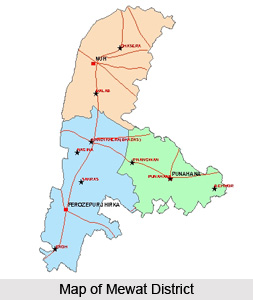 Mewat District was a part of Gurgaon and Faridabad district of Haryana until the year 2004. As a newly formed district it came into being on 4th April 2005 and became the 20th district of Haryana. Mewat district comprises of three sub-divisions that are Nuh, Firozpur Jhirka and Hathin with the district headquarter positioned at Nuh. The district consists of six blocks and five hundred thirty two villages, of which twenty seven villages are either uninhibited or are in control of Municipal Committees. Besides these the Mewat district is also a part of the Mewat region. The latter is of historical importance and lies both in the states of Haryana and Rajasthan.
Mewat District was a part of Gurgaon and Faridabad district of Haryana until the year 2004. As a newly formed district it came into being on 4th April 2005 and became the 20th district of Haryana. Mewat district comprises of three sub-divisions that are Nuh, Firozpur Jhirka and Hathin with the district headquarter positioned at Nuh. The district consists of six blocks and five hundred thirty two villages, of which twenty seven villages are either uninhibited or are in control of Municipal Committees. Besides these the Mewat district is also a part of the Mewat region. The latter is of historical importance and lies both in the states of Haryana and Rajasthan.
Mewat district is located at the southern boundary of Haryana. With an area of 1912 square km it is fifty km from the Delhi airport and thirty km from the city of Gurgaon and is bounded by it on the North. Rewari is on the West of Mewat district and Faridabad is on the East. The boundary of region of Mewat is not exactly determined but it includes within itself the Mewat district of Haryana and some parts of Dholpur, Bharatpur and Alwar district of Rajasthan and Mathura of Uttar Pradesh.
HISTORY OF MEWAT DISTRICT
The history of Mewat district is intertwined with that of the district. In fact Mewat region has an astonishing history and is said that it approximately corresponds to the Matsya kingdom of 5th century B.C. Hasan Khan Mewati was the most famous chieftain of Mewat who fought against Babur, the Mughal emperor, in the battle of Khanwa in 1527. It was under the Mughal rule that Mewat came under the Rajputs. This region for its odd location has experienced repeated attack all through the post-Vedic period which contributed to the backwardness of the region. The medieval India witnessed the rise of the Jats in certain parts of the Mewat region. However after the coming of the British it was annexed to the
GEOGRAPHY OF MEWAT DISTRICT
 Mewat lies between 26 degree and 30 degree North latitudes and 76 degree and 78 degree East longitude. It is bounded by Gurgaon district, Rewari district, Faridabad district in the north, west and east respectively. South wise it shares the margin with the state of Rajasthan. There is an irregularity as far as the landscape of Mewat is concerned. It has the hills and hillocks of the Aravali Mountain as well as the extensive plains. So geographically the region is divided into upland and lowland.
Mewat lies between 26 degree and 30 degree North latitudes and 76 degree and 78 degree East longitude. It is bounded by Gurgaon district, Rewari district, Faridabad district in the north, west and east respectively. South wise it shares the margin with the state of Rajasthan. There is an irregularity as far as the landscape of Mewat is concerned. It has the hills and hillocks of the Aravali Mountain as well as the extensive plains. So geographically the region is divided into upland and lowland.
Mewat district experience extremely hot temperature in summer as it falls under sub-tropical, semi-arid zone. Except for the monsoon season, the weather is normally dry. The temperature in the months of May and June ranges from 30C to 48C and in January it varies from 4C to 25C. Rainfall is at times accompanied by thunderstorms or hailstorms in the monsoon season. Humidity is low in greater part of the year and rises only during the monsoon.
DEMOGRAPHY OF MEWAT DISTRICT
The Census of India 2001 reads that the total population of Mewat district is 9, 93,617 of which 4.64% live in the urban areas and the majority of the population dwell in the rural areas. Of the total population, Mewat district has 5, 24,872 males and 4, 68,745 females. There are around 78,802 schedule castes inhabiting in the district. Mewat district consists of 1, 42,822 households out of which 1, 35,253 are in rural areas and remaining 7569 are in urban areas. Literacy rate for the Muslim women in Mewat district is the lowest in the country and even the literacy rate of men fall below the National average. It has two government degree colleges for a population of about a million.
Popularly referred to as the land of the Meos, Mewat district was originally inhabited by the people of Meo tribe who are primarily agriculturalist. They identify themselves as Kshatriyas and draw their lineage to the early Aryan of Northern India. Though during the rule of Tughlaq these people converted into Islam but till date, the Meos have conserved their ethnicity to a great extent.
ECONOMY OF MEWAT DISTRICT
The Meos are the predominant population of Mewat district and agriculture and agro-based activities are the main occupation of these people. Canal irrigation is available in few areas but rest of the agriculture in Mewat district is dependent on rain. Agriculture production calculated in terms of crop yield per hectare in Mewat district is comparatively low. Animal husbandry is the second choice of occupation for the people of Mewat district especially for those who live nearer to the hilly ranges of Aravali. The poultry population in Mewat district is comparatively less than in the rest of Haryana. However, because of the development of building activities in Gurgaon, the prices of land in Mewat district have risen significantly and are being bought by the developers and investors. People who have sold or are selling their agricultural land have made an abrupt increase of affluence. This has contributed to the strengthening of economy.

CULTURE OF MEWAT DISTRICT
Mewat district has large population of Muslims and are known as “Meo.†The Meos had embraced Islam during the reign of the Tughlaq dynasty. They were actually Rajput Hindus. Many Meos have retained their caste names and have preserved their ethnicity till date. They celebrate both Hindu and Muslim festivals. They follow the culture of Pals and Gotra as it is done by the Hindu Kshatriyas. Sat kumbh fair is one of the most important religious celebrations. It takes place twice a year. The Meos assimilate here in large numbers and the object of their pilgrimage is the tomb of Saint Shah Choka. This fair is also attended by the Hindus. The Meo men wear turbans around their head and put on long flowing gowns and the women abstain from wearing burkah.
The Mewat district is newly formed and the people are mainly engaged in agricultural activities. The literacy rate is very low but the preservation of the culture of the Meo tribe is indeed commendable.



















